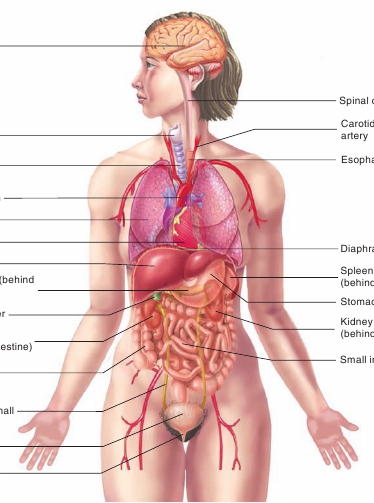6
PART 1 Organization of the Human Body

Brain
cord
Larynx
Trachea
Aortic arch
Lung
Heart
Liver
Pancreasstomach)
Gallbladder
Kidney(behind intestine)
Largeintestine
Ureter(behind smallintestine)
Urinarybladder
Urethra
Diaphragm
stomach)
Stomach
stomach)
intestine
Esophagus

FIGURE 1.2
Major Organs of the Body
specific functions. Living things are highly organized. Allorganisms are composed of one or more cells. Some cells in turnare composed of highly specialized organelles, which dependon the precise organization of large molecules. Disruption ofthis organized state can result in loss of functions, or even death.2.
Metabolism
(m ĕ -tab′ ō -lizm) refers to all of the chemicalreactions taking place in the cells and internal environmentof an organism. It includes an organism’s ability to breakdown food molecules, which the organism uses as a sourceof energy and raw materials to synthesize its own molecules.Energy is also used when one part of a molecule moves rela-tive to another part, changing the shape of the molecule. Insingle-celled organisms and certain human cells, this changein molecular shape can cause the whole cell to change shape.Sometimes this change in cell shape can allow the entireorganism or cell to move to a different location. Metabolismis necessary for other vital functions, such as responsiveness,growth, development, and reproduction.3.
Responsiveness
is an organism’s ability to sense changesin its external or internal environment and adjust to thosechanges. Responses include actions such as moving toward

Predict 3
In one type of diabetes, the pancreas fails to produce insulin, a chemicalnormally made by pancreatic cells and released into the blood. List asmany levels of organization as you can at which this disorder could becorrected.
1.3
Characteristics of Life
LEARNING OUTCOME
After reading this section, you should be able to
A.
List and define the six characteristics of life.
Humans are organisms, sharing characteristics with other organ-isms. The most important common feature of all organisms is life.This text recognizes six essential characteristics of life:
1.
Organization
refers to the specific interrelationships amongthe parts of an organism and how those parts interact to perform